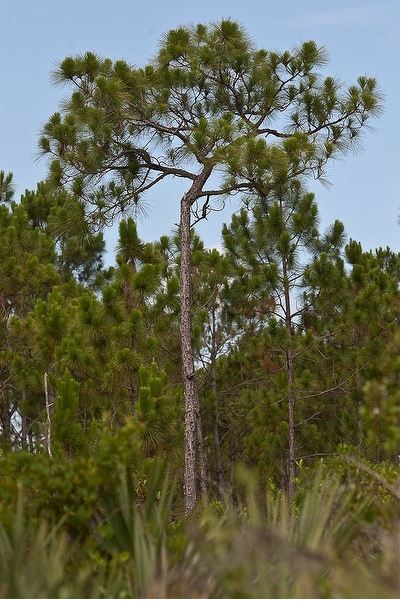Difference between revisions of "Pinus elliottii"
| Line 32: | Line 32: | ||
==Ecology== | ==Ecology== | ||
===Habitat=== <!--Natural communities, human disturbed habitats, topography, hydrology, soils, light, fire regime requirements for removal of competition, etc.--> | ===Habitat=== <!--Natural communities, human disturbed habitats, topography, hydrology, soils, light, fire regime requirements for removal of competition, etc.--> | ||
| − | ''P. elliottii'' proliferates in wet pine flatwoods and maritime forests. <ref name= "Weakley 2015"> Weakley, A. S. (2015). Flora of the Southern and Mid-Atlantic States. Chapel Hill, NC, University of North Carolina Herbarium. </ref> | + | ''P. elliottii'' proliferates in wet pine flatwoods and maritime forests. <ref name= "Weakley 2015"> Weakley, A. S. (2015). Flora of the Southern and Mid-Atlantic States. Chapel Hill, NC, University of North Carolina Herbarium. </ref> Specimens have been collected from sandy soils with virgin slash pine flatwoods, hollows between stable sand dunes, on bay shore of island, mixed hardwood swamp, pine plantation, open grassy field, in dry loamy sand of sandhill flat, longleaf pine community, and pine-oak-sweet gum woods. <ref name = "FSU herbarium"> URL: http://herbarium.bio.fsu.edu. Last accessed: June 2018. Collectors: Andre F. Clewell, E.A. Hebb, Elbert L. Little Jr., R.K. Godfrey, Cecil Slaughter, D.B. Ward, Poppleton, A.G. Shuey, Robert Kral, Patricia Elliot, Gwynn W. Ramsey, H. Larry E. Stripling, Loran Anderson, Bruce Hansen, T. Myint, R.R> Smith, F.C. Craighead, R. Komarek. States and counties: Florida (Wakulla, Hendry, Franklin, Leon, Flagler, lake, Monroe, Martin, Liberty, Madison, Gadsden, Lee, Highlands, Dade, Osceola) Georgia (Grady) </ref> |
<!--===Phenology===--> <!--Timing off flowering, fruiting, seed dispersal, and environmental triggers. Cite PanFlora website if appropriate: http://www.gilnelson.com/PanFlora/ --> | <!--===Phenology===--> <!--Timing off flowering, fruiting, seed dispersal, and environmental triggers. Cite PanFlora website if appropriate: http://www.gilnelson.com/PanFlora/ --> | ||
<!--===Seed dispersal===--> | <!--===Seed dispersal===--> | ||
<!--===Seed bank and germination===--> | <!--===Seed bank and germination===--> | ||
| + | |||
===Fire ecology=== <!--Fire tolerance, fire dependence, adaptive fire responses--> | ===Fire ecology=== <!--Fire tolerance, fire dependence, adaptive fire responses--> | ||
''P. elliottii'' is fire resistant, but has a low fire tolerance. <ref name= "USDA Plant Database"/> ''P. elliottii'' var. ''densa'' has thick bark as an adult and a 'grass' stage as a juvenile that offer resistance to fire damage. <ref name= "Abrahamson 1996"> Abrahamson, W. G. and C. R. Abrahamson (1996). "Effects of Fire on Long-Unburned Florida Uplands." Journal of Vegetation Science 7(4): 565-574. </ref> | ''P. elliottii'' is fire resistant, but has a low fire tolerance. <ref name= "USDA Plant Database"/> ''P. elliottii'' var. ''densa'' has thick bark as an adult and a 'grass' stage as a juvenile that offer resistance to fire damage. <ref name= "Abrahamson 1996"> Abrahamson, W. G. and C. R. Abrahamson (1996). "Effects of Fire on Long-Unburned Florida Uplands." Journal of Vegetation Science 7(4): 565-574. </ref> | ||
Revision as of 13:43, 25 June 2018
Common name: slash pine [1]
| Pinus elliottii | |
|---|---|

| |
| Photo by John B hosted at Bluemelon.com/poaceae | |
| Scientific classification | |
| Kingdom: | Plantae |
| Division: | Magnoliophyta - Flowering plants |
| Class: | Magnoliopsida - Dicots |
| Order: | Pinales |
| Family: | Pinaceae |
| Genus: | Pinus |
| Species: | P. elliottii |
| Binomial name | |
| Pinus elliottii Engelm. | |

| |
| Natural range of Pinus elliottii from USDA NRCS Plants Database. | |
Contents
Taxonomic Notes
Synonyms: P. elliottii var. elliottii; P. heterophylla
Varieties: none
Description
P. elliottii is a perennial tree of the Pinaceae family native to North America. [2]
Distribution
P. elliottii is found along the southeastern coast of the United States from Texas to North Carolina. [2]
Ecology
Habitat
P. elliottii proliferates in wet pine flatwoods and maritime forests. [1] Specimens have been collected from sandy soils with virgin slash pine flatwoods, hollows between stable sand dunes, on bay shore of island, mixed hardwood swamp, pine plantation, open grassy field, in dry loamy sand of sandhill flat, longleaf pine community, and pine-oak-sweet gum woods. [3]
Fire ecology
P. elliottii is fire resistant, but has a low fire tolerance. [2] P. elliottii var. densa has thick bark as an adult and a 'grass' stage as a juvenile that offer resistance to fire damage. [4]
Conservation and Management
Cultivation and restoration
Photo Gallery
References and notes
- ↑ 1.0 1.1 Weakley, A. S. (2015). Flora of the Southern and Mid-Atlantic States. Chapel Hill, NC, University of North Carolina Herbarium.
- ↑ 2.0 2.1 2.2 USDA Plant Database https://plants.usda.gov/core/profile?symbol=PIEL
- ↑ URL: http://herbarium.bio.fsu.edu. Last accessed: June 2018. Collectors: Andre F. Clewell, E.A. Hebb, Elbert L. Little Jr., R.K. Godfrey, Cecil Slaughter, D.B. Ward, Poppleton, A.G. Shuey, Robert Kral, Patricia Elliot, Gwynn W. Ramsey, H. Larry E. Stripling, Loran Anderson, Bruce Hansen, T. Myint, R.R> Smith, F.C. Craighead, R. Komarek. States and counties: Florida (Wakulla, Hendry, Franklin, Leon, Flagler, lake, Monroe, Martin, Liberty, Madison, Gadsden, Lee, Highlands, Dade, Osceola) Georgia (Grady)
- ↑ Abrahamson, W. G. and C. R. Abrahamson (1996). "Effects of Fire on Long-Unburned Florida Uplands." Journal of Vegetation Science 7(4): 565-574.